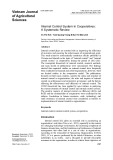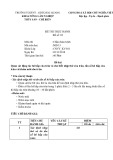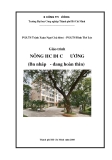
HPU2. Nat. Sci. Tech. Vol 02, issue 03 (2023), 59-66
HPU2 Journal of Sciences:
Natural Sciences and Technology
journal homepage: https://sj.hpu2.edu.vn
Article type: Research article
Received date: 25-9-2023 ; Revised date: 05-12-2023 ; Accepted date: 11-12-2023
This is licensed under the CC BY-NC-ND 4.0
Synchronization for fractional-order neural networks with
unbounded delays
Thi-Hong Duonga,*,Thu-Loan Vu Thib
a Thai Nguyen University of Sciences, Thai Nguyen, Viet Nam
bThai Nguyen University of Agriculture and Forestry, Thai Nguyen, Viet Nam
Abstract
This paper deals with synchronization analysis problem for a class of fractional-order neural networks
with unbounded delays. Using the Lyapunov function method combined with fractional Halanay
inequality, we derive a novel sufficient condition for asymptotic stability of the error system resulting
in two neural networks are synchronized. The obtained conditions are given in terms of linear matrix
inequalities, which therefore can be efficiently checked. A numerical example is proposed to illustrate
the effectiveness of the obtained results.
Keywords: Fractional order neural networks, synchronization analysis, unbounded delays, lyapunov
function, asymptotic stable
1. Introduction
Neural networks have received the attention of many scientists in recent years due to its wide
applications in image processing, combinatorial optimization, pattern recognition, adaptive control,
and other areas [3, 13]. Theory of fractional calculus has been shown to be superior to classical
differential and integral calculation in simulating materials and processes with memory [4, 9, 10, 11].
So, the neural networks model described by the fractional-order differential equation systems can
describe the characteristics and properties of dynamical systems more efficiently and accurately. As a
* Corresponding author, E-mail: hongdt@tnus.edu.vn
https://doi.org/10.56764/hpu2.jos.2023.2.3.59-66

HPU2. Nat. Sci. Tech. 2023, 2(3), 59-66
https://sj.hpu2.edu.vn 60
consequence, many important and interesting results on fractional-order neural networks have been
reported and various issues have been studied by many authors [8, 14, 16].
Synchronization is a procedure in which two or more systems react with each other, leading to a
joint development in some of their dynamic characteristics. The synchronization problem of integer
order dynamic systems has received a lot of attention over the years [1, 5, 12]. However, the
synchronization problem of fractional order neural networks is still limited. The reason is that the
fractional order differential equations do not produce a semi-group operator. Therefore, we cannot
easily extend the results of the synchronization problem for integer neural networks to fractional order
neural networks.
This paper focuses on studying the synchronization analysis problem for a class of fractional
order neural networks with unbounded delays by using Lyapunov functional method combined with
fractional Halanay inequality and linear matrix inequality techniques. Compared with the previous
work of fractional order neural networks [6], our result is more advantageous because the condition is
given in the form of linear matrix inequalities, which can be effectively solved by various
computational tools.
The remainder of this paper is organized as follows: Section 2 gives the main concepts and
lemmas. Section 3 presents a synchronization scheme for fractional-order neural networks with
unbounded delays. A numerical example is provided in Section 4 to illustrate the effectiveness of the
proposed method.
Notations: ℝ𝒏 and ℝ𝒏×𝒎 stand for the 𝒏-dimensional vector space and real (𝒏×𝒎) matrices,
respectively. For any matrix 𝑺∈ℝ𝒏×𝒏,𝑺>𝟎(𝑺<𝟎) means that it is positive-definite (negative-
definite matrix) respectively, if 𝑺=𝑺𝑻 and 𝒙𝑻𝑺𝒙>𝟎 (𝒙𝑻𝑺𝒙<𝟎),∀𝒙∈ℝ𝒏.𝑺𝑻denotes the
transposed matrix of 𝑺. The symbol ∗ stands for symmetric block elements in a matrix. The operator
𝐝𝐢𝐚𝐠 {.} 𝐫𝐞𝐩𝐫𝐞𝐬𝐞𝐧𝐭𝐬 𝐚 diagonal matrix. 𝐬𝐲𝐦 (𝑷) stands for 𝑷+𝑷𝑻,
⟨,⟩ 𝐫𝐞𝐩𝐫𝐞𝐬𝐞𝐧𝐭𝐬 𝐭𝐡𝐞 𝐢𝐧𝐧𝐞𝐫 𝐩𝐫𝐨𝐝𝐮𝐜𝐭.
2. Problem statement and preliminaries
Firstly, we introduce some concepts and properties of the fractional calculus, which are necessary
for this present work.
Definition 1. ([9]) The Riemann-Liouville fractional integral and derivative of order 𝛼>0 of a
function 𝑥(𝑡) are defined as follows, respectively
𝐼𝑡𝛼𝑥(𝑡)= 1
Γ(𝛼)∫ 𝑡
𝑎 (𝑡−𝑠)𝛼−1𝑥(𝑠)𝑑𝑠,𝑡≥0,
0
𝑅𝐷𝑡𝛼𝑥(𝑡)=𝑑𝑛
𝑑𝑡𝑛(𝐼𝑡𝑛−𝛼𝑥(𝑡)),𝑡≥0,
where 𝑛=[𝛼]+1,Γ(.) is the gamma function,Γ(𝑠)=∫0∞ 𝑒−𝑡𝑡𝑠−1𝑑𝑡,𝑠>0.
Definition 2. ([9]) The Caputo derivative of order 𝛼>0 is defined by
0
𝐶𝐷𝑡𝛼𝑥(𝑡)= 0
𝑅𝐷𝑡𝛼[𝑥(𝑡)−∑
𝑛−1
𝑘=0 𝑥(𝑘)(0)
𝑘! 𝑡𝑘],
where 𝑛=[𝛼]+1.
Particularly, for 0<𝛼<1,

HPU2. Nat. Sci. Tech. 2023, 2(3), 59-66
https://sj.hpu2.edu.vn 61
0
𝐶𝐷𝑡𝛼𝑥(𝑡)= 0
𝑅𝐷𝑡𝛼[𝑥(𝑡)−𝑥(0)].
Next, the following useful properties of fractional calculus are given, which are used in this
paper.
Property 1. ([9]) If 𝑥(.)∈𝐿1[0,+∞) and 0<𝛼<1, then
𝐼𝑡𝛼( 0
𝐶𝐷𝑡𝛼𝑥(𝑡))=𝑥(𝑡)−𝑥(0).
Property 2. ([9]) If 𝑥(.)∈𝐶[0,𝑇], then we have
𝐼𝑡𝛼1(𝐼𝑡𝛼2𝑥(𝑡))=𝐼𝑡𝛼2(𝐼𝑡𝛼1𝑥(𝑡))=𝐼𝑡𝛼1+𝛼2(𝑥(𝑡)),∀𝑡≥0,𝛼1,𝛼2>0.
Consider the following two fractional-order neural networks
{ 0
𝐶𝐷𝑡𝛼𝑥(𝑡)=−𝐴𝑥(𝑡)+𝐵𝑓(𝑥(𝑡))+𝐶𝑔(𝑥(𝑡−𝜏(𝑡)),
𝑝(𝑡)=𝐻𝑥(𝑡), (1)
{ 0
𝐶𝐷𝑡𝛼𝑦(𝑡)=−𝐴𝑦(𝑡)+𝐵𝑓(𝑦(𝑡))+𝐶𝑔(𝑦(𝑡−𝜏(𝑡))+𝑊𝑢(𝑡),
𝑞(𝑡)=𝐻𝑦(𝑡), (2)
where 𝛼∈(0,1) is the fractional order of the systems, 𝑥(𝑡)∈ℝ𝑛 is the state vector of the system
(1), 𝑦(𝑡)∈ℝ𝑛 is the state vector of the system (2), 𝑢(𝑡)∈ℝ𝑘 is the control vector, 𝑝(𝑡),𝑞(𝑡)∈ℝ𝑙
are the output vectors, 𝑓(.)=(𝑓1(.),.…,𝑓𝑚(.))∈ℝ𝑚,𝑔(.)=(𝑔1(.),.…,𝑔𝑚(.))∈ℝ𝑚 are
activation functions, the timevarying function 𝜏(𝑡) satisfying 𝑡−𝜏(𝑡)≥−ℎ for all 𝑡≥0 and 𝑡−
𝜏(𝑡)→∞ as 𝑡→∞.𝐴∈ℝ𝑛×𝑛 is the diagonal positive definite matrix, 𝐵∈ℝ𝑛×𝑚 is the connection
weight matrix, 𝐶∈ℝ𝑛×𝑚 is the delayed connection weight matrix of the model and 𝑊∈ℝ𝑛×𝑘,𝐻∈
ℝ𝑙×𝑛 are known real constant matrices.
Assumption 1. The activation functions 𝑓𝑖(.) and 𝑔𝑖(.) (𝑖=1,2,…,𝑚) are continuous, 𝑓𝑖(0)=
𝑔𝑖(0)=0 and satisfy the following conditions on ℝ for some known positive scalars 𝑙𝑖,𝑘𝑖(𝑖=
1,2,…,𝑛)
𝑙𝑖−≤𝑓𝑖(𝑎)−𝑓𝑖(𝑏)
𝑎−𝑏 ≤𝑙𝑖+, (3)
𝑡𝑖−≤𝑔𝑖(𝑎)−𝑔𝑖(𝑏)
𝑎−𝑏 ≤𝑡𝑖+, (4)
∀𝑎,𝑏∈ℝ,𝑎≠𝑏.
Set 𝐿1=diag {𝑙1−,𝑙2
−,…,𝑙𝑛
−},𝐿2=diag {𝑙1+,𝑙2
+,…,𝑙𝑛
+},
𝑇1=diag {𝑡1−,𝑡2−,…,𝑡𝑛
−},𝑇2=diag {𝑡1+,𝑡2+,…,𝑡𝑛+}.
We define the error as 𝑒(𝑡)=𝑥(𝑡)−𝑦(𝑡),𝑧(𝑡)=𝑝(𝑡)−𝑞(𝑡), and set 𝑝(𝑡)=𝑓(𝑥(𝑡))−
𝑓(𝑦(𝑡)),q(𝑡− 𝜏(𝑡))=𝑔(𝑥(𝑡−𝜏(𝑡))−𝑔(𝑦(𝑡−𝜏(𝑡), the relevant error system can be formulated by
{ 0
𝐶𝐷𝑡𝛼𝑒(𝑡)=−𝐴𝑒(𝑡)+𝐵𝑝(𝑡)+𝐶𝑞(𝑡−𝜏(𝑡))−𝑊𝑢(𝑡),
𝑧(𝑡)=𝐻𝑒(𝑡). (5)
With the control law 𝑢(𝑡)=𝐾𝑧(𝑡)=𝐾𝐻𝑒(𝑡), the corresponding closed-loop system of the
system (5) is
{ 0
𝐶𝐷𝑡𝛼𝑒(𝑡)=(−𝐴−𝑊𝐾𝐻)𝑒(𝑡)+𝐵𝑝(𝑡)+𝐶𝑞(𝑡−𝜏(𝑡)),
𝑧(𝑡)=𝐻𝑒(𝑡). (6)
Definition 3. Systems (1) and (2) are said to be completely synchronized if the error vector 𝑒(𝑡)

HPU2. Nat. Sci. Tech. 2023, 2(3), 59-66
https://sj.hpu2.edu.vn 62
converges to zero, that is, lim
𝑡→∞ ∥𝑒(𝑡)∥=lim
𝑡→∞ ∥𝑥(𝑡)−𝑦(𝑡)∥=0.
Below, we recall several technical lemmas for deriving the main results.
Lemma 1. ([15]) Let 𝑉:ℝ𝑛→ℝ+be a convex and differentiable function on ℝ𝑛 such that
𝑉(0)=0 and 𝛼∈(0,1),𝑥(𝑡)∈ℝ𝑛 be a continuous function. We get
0
𝐶𝐷𝑡𝛼𝑉(𝑥(𝑡))≤⟨∇𝑉(𝑥(𝑡)), 0
𝐶𝐷𝑡𝛼𝑥(𝑡))⟩,𝑡≥0
where ∇𝑉(.) is the gradient of the function 𝑉 and ⟨,⟩ is the inner product.
Lemma 2. (Fractional-order Hanalay inequality, [7]) Let 𝛼∈(0,1) and 𝑉:[−ℎ,∞]→ℝ+be
continuous on [0,∞) and bounded on [−ℎ,0]. Asume that 𝜏(.)∈𝐶(ℝ+,ℝ+)satisfies 𝜏(𝑡)≤𝑡+ℎ for
some fixed ℎ>0,𝑡−𝜏(𝑡)→∞ as 𝑡→∞. For some scalars 𝜆>𝜅>0, the following inequality
holds 0
𝐶𝐷𝑡𝛼𝑉(𝑡)≤−𝜆𝑉(𝑡)+𝜅 sup
−𝜏(𝑡)≤𝜎≤0 𝑉(𝑡+𝜎),
for all 𝑡≥0. Then lim
𝑡→∞ 𝑉(𝑡)=0.
Lemma 3. ([2]) Given 𝐸∈ℝ𝑝×𝑝,𝐺∈ℝ𝑝×𝑞,𝑍∈ℝ𝑞×𝑝,𝑈∈ℝ𝑞×𝑞 and scalar 𝜁. Inequality
𝐸+𝑍𝑇𝐺𝑇+𝐺𝑍<0.
is fulfilled if the following condition holds
[𝐸𝜁𝐺+𝑍𝑇𝑈𝑇
∗ −𝜁𝑈−𝜁𝑈𝑇]<0.
3. The synchronization scheme for fractional-order neural networks with unbounded delays
The following theorem presents a sufficient condition for the error system (6) to be
asymptotically stable resulting in the system (1) and the system (2) are synchronized.
Theorem 1. The system (6) is asymptotically stable if there exist a symmetric positive definite
matrix 𝑃∈ℝ𝑛×𝑛, two positive definite diagonal matrix 𝛴,𝛥∈ℝ𝑚×𝑚, a non-singular matrix 𝛬∈
ℝ𝑛×𝑘, a matrix 𝑈 and two positive numbers 𝜆>𝜅 such that the following condition holds
[
𝛺11 0𝑃𝐵+(𝐿1+𝐿2)𝛴𝑃𝐶 𝛺15
∗ −𝜅𝑃−2𝑇1𝛥𝑇20(𝑇1+𝑇2)𝛥 0
∗ ∗ −2𝛴 0 0
∗ ∗ ∗ −2𝛥 0
∗ ∗ ∗ ∗ 𝛺55
]
<0, (7)
where 𝛺11=−𝑃𝐴−𝐴𝑇𝑃−2𝐿1𝛴𝐿2+𝜆𝑃−𝑊𝑈𝐻−𝐻𝑇𝑈𝑇𝑊𝑇,
𝛺15=𝜁(𝑊𝛬−𝑃𝑊)+𝐻𝑇𝑈𝑇,
𝛺55=−𝜁𝑈−𝜁𝑈𝑇.
In addition, the control gain matrix is given by 𝐾=𝛬−1𝑈.
Proof. Consider the Lyapunov function candidate for the system (6)
𝑉(𝑒(𝑡))=𝑒𝑇(𝑡)𝑃𝑒(𝑡)
where 𝑃∈ℝ𝑛×𝑛 is a symmetric positive definite matrix.

HPU2. Nat. Sci. Tech. 2023, 2(3), 59-66
https://sj.hpu2.edu.vn 63
Using Lemma 1, we calculate 𝛼(0<𝛼<1) Caputo derivative of 𝑉(𝑒(𝑡)) along the trajectories
of system (6) as follows
0
𝐶𝐷𝑡𝛼𝑉(𝑒(𝑡))≤2𝑒𝑇(𝑡)𝑃 0
𝐶𝐷𝑡𝛼𝑒(𝑡)
=2𝑒𝑇(𝑡)𝑃[(−𝐴−𝑊𝐾𝐻)𝑒(𝑡)+𝐵𝑝(𝑡)+𝐶𝑞(𝑡−𝜏(𝑡))]
=𝑒𝑇(𝑡)(−𝑃𝐴−𝐴𝑇𝑃−𝑃𝑊𝐾𝐻−𝐻𝑇𝐾𝑇𝑊𝑇𝑃)𝑒(𝑡)
+2𝑒𝑇(𝑡)𝑃𝐵𝑝(𝑡)+2𝑒𝑇(𝑡)𝑃𝐶𝑞(𝑡−𝜏(𝑡)). (8)
From (3), it is easy to derive that
[𝑝𝑇(𝑡)−𝑒𝑇(𝑡)𝐿1][𝑝(𝑡)−𝐿2
⬚𝑒(𝑡)]≤0. (9)
Therefore, for any positive definite diagonal matrix Σ, we always have
−2𝑝𝑇(𝑡)Σ𝑝(𝑡)+2𝑒𝑇(𝑡)(𝐿1+𝐿2)Σ𝑝(𝑡)−2𝑒𝑇(𝑡)𝐿1Σ𝐿2𝑒(𝑡)≥0. (10)
Similarly, inequality (4) results
−2𝑞𝑇(𝑡−𝜏(𝑡))Δ𝑞(𝑡−𝜏(𝑡))+2𝑒𝑇(𝑡−𝜏(𝑡))(𝑇1+𝑇2)Δ𝑞(𝑡−𝜏(𝑡))
−2𝑒𝑇(𝑡−𝜏(𝑡))𝑇1Δ𝑇2𝑒(𝑡−𝜏(𝑡))≥0, (11)
where diagonal matrix Δ>0.
From conditions (8)-(11), we obtain
0
𝐶𝐷𝑡𝛼𝑉(𝑒(𝑡)) ≤𝑒𝑇(𝑡)(−𝑃𝐴−𝐴𝑇𝑃−𝑃𝑊𝐾𝐻−𝐻𝑇𝐾𝑇𝑊𝑇𝑃)𝑒(𝑡)
+2𝑒𝑇(𝑡)𝑃𝐵𝑝(𝑡)+2𝑒𝑇(𝑡)𝑃𝐶𝑞(𝑡−𝜏(𝑡))−2𝑝𝑇(𝑡)Σ𝑝(𝑡)
+2𝑒𝑇(𝑡)(𝐿1+𝐿2)Σ𝑝(𝑡)−2𝑒𝑇(𝑡)𝐿1Σ𝐿2𝑒(𝑡)
−2𝑞𝑇(𝑡−𝜏(𝑡))Δ𝑞(𝑡−𝜏(𝑡))+2𝑒𝑇(𝑡−𝜏(𝑡))(𝑇1+𝑇2)Δ𝑞(𝑡−𝜏(𝑡))
−2𝑒𝑇(𝑡−𝜏(𝑡))𝑇1Δ𝑇2𝑒(𝑡−𝜏(𝑡))
=𝑒𝑇(𝑡)(−𝑃𝐴−𝐴𝑇𝑃−𝑃𝑊𝐾𝐻−𝐻𝑇𝐾𝑇𝑊𝑇𝑃−2𝐿1Σ𝐿2)𝑒(𝑡)
+2𝑒𝑇(𝑡)(𝑃𝐵+(𝐿1+𝐿2)Σ)𝑝(𝑡)+2𝑒𝑇(𝑡)𝑃𝐶𝑞(𝑡−𝜏(𝑡))
+2𝑒𝑇(𝑡−𝜏(𝑡))(𝑇1+𝑇2)Δ𝑞(𝑡−𝜏(𝑡))
−2𝑝𝑇(𝑡)Σ𝑝(𝑡)−2𝑞𝑇(𝑡−𝜏(𝑡))Δ𝑞(𝑡−𝜏(𝑡))
−2𝑒𝑇(𝑡−𝜏(𝑡))𝑇1Δ𝑇2𝑒(𝑡−𝜏(𝑡)).
Hence, with constants 𝜆>𝜅>0, we have
0
𝐶𝐷𝑡𝛼𝑉(𝑒(𝑡))+𝜆𝑉(𝑒(𝑡))−𝜅 sup
−𝜏(𝑡)≤𝜎≤0 𝑉(𝑒(𝑡+𝜎))
≤𝑒𝑇(𝑡)(−𝑃𝐴−𝐴𝑇𝑃−𝑃𝑊𝐾𝐻−𝐻𝑇𝐾𝑇𝑊𝑇𝑃−2𝐿1Σ𝐿2)𝑒(𝑡)
+2𝑒𝑇(𝑡)(𝑃𝐵+(𝐿1+𝐿2)Σ)𝑝(𝑡)+2𝑒𝑇(𝑡)𝑃𝐶𝑞(𝑡−𝜏(𝑡))
+2𝑒𝑇(𝑡−𝜏(𝑡))(𝑇1+𝑇2)Δ𝑞(𝑡−𝜏(𝑡))
−2𝑝𝑇(𝑡)Σ𝑝(𝑡)−2𝑞𝑇(𝑡−𝜏(𝑡))Δ𝑞(𝑡−𝜏(𝑡))−2𝑒𝑇(𝑡−𝜏(𝑡))𝑇1Δ𝑇2𝑒(𝑡−𝜏(𝑡))
+𝜆𝑒𝑇(𝑡)𝑃𝑒(𝑡)−𝜅 sup
−𝜏(𝑡)≤𝜎≤0 𝑒𝑇(𝑡+𝜎)𝑃𝑒(𝑡+𝜎)
≤𝑒𝑇(𝑡)(−𝑃𝐴−𝐴𝑇𝑃−𝑃𝑊𝐾𝐻−𝐻𝑇𝐾𝑇𝑊𝑇𝑃−2𝐿1Σ𝐿2+𝜆𝑃)𝑒(𝑡)
+2𝑒𝑇(𝑡)(𝑃𝐵+(𝐿1+𝐿2)Σ)𝑝(𝑡)+2𝑒𝑇(𝑡)𝑃𝐶𝑞(𝑡−𝜏(𝑡))


























